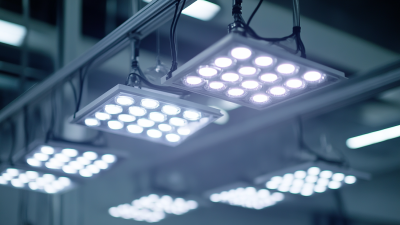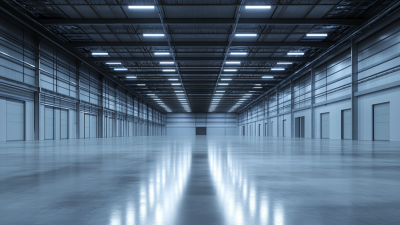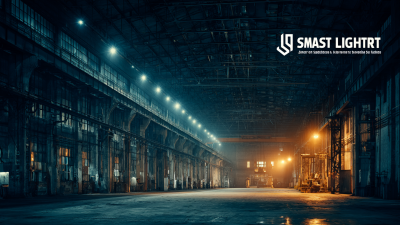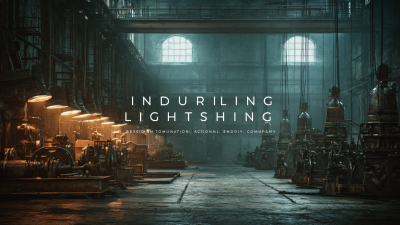
Choosing the right industrial lamps for your workspace is essential for optimizing productivity and ensuring safety. According to a recent report from the Illuminating Engineering Society, up to 80% of work-related accidents can be attributed to poor lighting conditions, highlighting the crucial role that effective industrial lighting plays in maintaining a safe environment. Additionally, the global industrial lighting market is projected to reach $6.75 billion by 2025, driven by advancements in LED technology and increasing energy efficiency regulations. In this context, selecting suitable industrial lamps not only improves visibility but also contributes to long-term operational cost savings. As industries increasingly prioritize sustainability, understanding the specific lighting needs of various work environments will be key to making informed decisions on industrial lamp selection.

When selecting industrial lamps for your workspace, several key factors come into play to ensure optimal illumination and efficiency. One crucial aspect is the lumen output, which measures the total amount of light emitted by a lamp. According to the Illuminating Engineering Society (IES), a workspace should typically provide anywhere from 300 to 750 lumens per square meter, depending on the nature of the tasks performed. For high-detail work areas, such as assembly lines or laboratories, aiming for the upper end of this range can enhance productivity and safety.
Another important consideration is energy efficiency. The U.S. Department of Energy reports that LED lighting consumes up to 75% less energy than traditional incandescent bulbs while lasting approximately 25 times longer. This not only reduces operational costs but also aligns with sustainability goals. Additionally, assessing the Color Rendering Index (CRI) is vital, particularly in environments requiring precise color differentiation, like painting or quality control. A CRI of 80 or above is generally recommended for industrial settings to ensure colors are rendered accurately, thus facilitating better decision-making and reducing errors.

When selecting industrial lamps for your workspace, understanding the types available and their optimal applications is crucial. Firstly, LED industrial lights are becoming increasingly popular due to their energy efficiency and long lifespan. They are perfect for warehouses and factories where bright, consistent lighting is required to ensure safety and productivity. Their low heat emission also makes them an excellent choice for environments that require cooler operations.
Another type to consider is fluorescent lighting, which offers a softer light suitable for assembly lines and offices within industrial settings. These lamps have a higher color rendering index compared to traditional bulbs, making them ideal for tasks that require precise color differentiation. Additionally, high-intensity discharge (HID) lamps are often used for large open areas, such as loading docks and outdoor spaces. Their high lumen output ensures that even the most expansive areas are well-lit, enhancing visibility and security throughout the workspace. Each type of lamp serves specific needs, making it essential to evaluate the particular requirements of your facility before making a choice.
| Lamp Type | Description | Optimal Applications | Energy Efficiency |
|---|---|---|---|
| LED Flood Lights | High-intensity illumination suitable for large areas. | Warehouses, outdoor areas, construction sites. | Highly efficient, up to 80% less energy than traditional lights. |
| Industrial Pendant Lights | Hangs from the ceiling to provide direct lighting. | Manufacturing areas, assembly lines, and workstations. | Good energy efficiency with options for LED. |
| High Bay Lights | Designed for high ceilings to provide broad illumination. | Large warehouses, gymnasiums, and factories. | LED options are very energy-efficient. |
| Task Lights | Focused lighting for specific tasks with adjustable features. | Workstations, repair shops, and design areas. | Can be very efficient using LED technology. |
| Emergency Lighting | Backup lighting in case of power failure. | Egress paths, exits, and critical operation areas. | Varies by type; LED options available are efficient. |
When selecting industrial lamps for your workspace, energy efficiency should be a primary consideration. According to the U.S. Department of Energy, lighting uses about 17% of the total energy consumed in commercial buildings, highlighting the significant impact that choosing the right lighting solutions can have on energy costs and sustainability. By opting for LED lighting, businesses can reduce energy consumption by nearly 75% compared to traditional incandescent bulbs. This transition not only translates into lower electricity bills but also contributes to a reduction in greenhouse gas emissions.
Additionally, the implementation of energy-efficient lighting can enhance productivity and safety in the workplace. A study from the Pacific Northwest National Laboratory found that improved lighting led to a 15% increase in worker productivity. Moreover, high-quality industrial lamps designed for energy efficiency can provide better illumination, minimizing the chances of accidents. As organizations increasingly seek sustainable operational practices, investing in energy-efficient lighting solutions offers a dual benefit - fostering a safer work environment while aligning with corporate sustainability goals.
When selecting industrial lamps for your workspace, assessing light quality and safety standards is crucial. Quality of light can significantly impact productivity and worker safety. Look for lamps that provide adequate illumination levels, measured in lumens, tailored to your specific tasks. A well-lit environment reduces eye strain and enhances visibility, ensuring employees can perform their duties effectively.
**Tips:** Always opt for lighting that offers a high color rendering index (CRI), typically above 80, to ensure true color visibility, which is particularly important for tasks requiring precision. Additionally, consider the color temperature of the lamp; warm white (3000K) may create a comfortable atmosphere, while cool white (5000K) can enhance alertness in more industrial settings.
Safety standards also play a pivotal role in your choice of industrial lamps. It's essential to choose lighting solutions that comply with local and international safety regulations, such as the OSHA standards in the U.S. Look for fixtures with durable construction and protection against hazards like dust and moisture.
**Tips:** Implement emergency lighting that meets safety codes, ensuring that exits and pathways remain illuminated during power outages. Regular maintenance checks on lighting systems also help in adhering to safety protocols while ensuring optimal performance in your workspace.

When selecting industrial lamps for your workspace, cost-effectiveness must be at the forefront of your decision-making process. Identifying the right balance between budget constraints and lighting requirements can significantly impact productivity and safety. Start by assessing your specific lighting needs based on the tasks performed in the workspace. Areas that require precision may need brighter, more focused lighting, while general areas may benefit from softer illumination. Investing in LED lighting solutions, although they may have a higher upfront cost, can lead to substantial savings in energy consumption and longevity over time, ultimately reducing overall expenses.
Moreover, it’s essential to consider the total cost of ownership instead of just the initial purchase price. This includes maintenance, energy usage, and replacement frequency of lamps. Opting for higher-quality fixtures that are durable and reliable can prove to be a cost-efficient solution in the long run. Additionally, take advantage of any government rebates or incentives for energy-efficient lighting systems, as these can offset the initial investment and enhance your workspace's overall budgetary health. By strategically balancing cost with lighting needs, businesses can create a well-lit, safe, and productive environment without overspending.
This chart illustrates the cost per unit for different types of industrial lamps, which can help you in making cost-effective decisions for your workspace lighting needs.






Let us help you get started with our superior LED lighting products.
Get all the latest news from BrightLED.
Copyright © Bright LED. All rights reserved.
STAY CONNECTED

